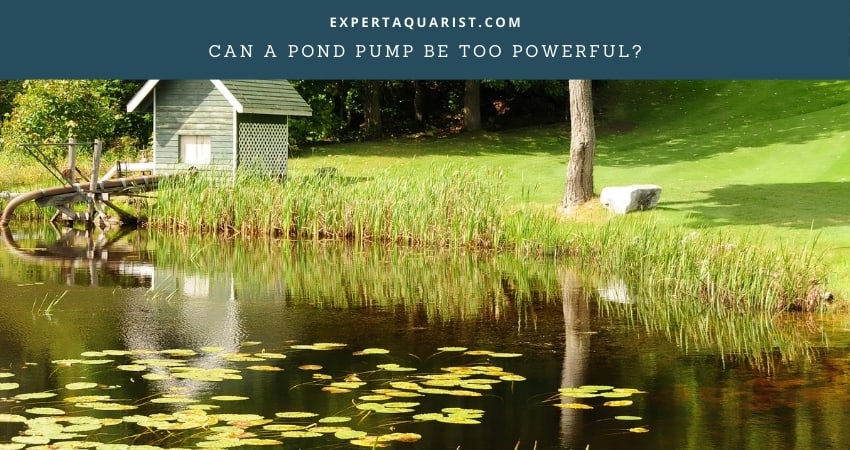If you have a pond in your backyard, it is a must for you to install a pond pump in it. Not only does it increase the beauty of the pond by adding things like a waterfall, but it also makes the water move, which circulates the water and produces oxygen to keep the fish healthy. But sometimes, the pump itself might be the problem.
The first thing to consider when you are looking for a new pond pump is, “can a pond pump be too powerful for your pond?” Sometimes the pump can be bigger and more powerful than what you would need in a pond. This creates a whole host of problems from water loss to the loss of the fishes’ lives.
Let’s read below to understand it more deeply!
Signs that the pump is too powerful
Can a pond pump be too powerful? – Yes, it certainly can. This usually happens when you install a pump into your pond which has a larger capacity than the volume of water in the pond. If it is the case, then you can identify it by noticing a few signs. They are :
- Loss of Water: If you have a pump that is too powerful for your pond, it will shoot the water too high or the waterfall will be so powerful that the water will tend to fall on the surrounding area of the pond, resulting in losing water from your pond.
- Loud Noise: Another sign that your pump is more powerful than you need is that it will be a noisy one. If you can’t even hear yourself talking or hear someone from across the fence, then take it as a sign that you have the wrong sized pump.
- Muddy water: If the pump is too powerful, it will heave the water around. This will disturb the mud and soil at the bottom, making the pond murky. So, if your pond suddenly becomes murky, chances are that it is because of a pump more powerful than it is required.
- Gushing of water: The waterfall you want for your pond should be a mild one. The water should trickle onto the pond. But if the waterfall resembles a hosepipe, or worse, Niagara falls, then definitely you have a pump that is way too powerful for the size of your pond.
- Effect on the filter: If the pump is too powerful, it will create overwhelming pressure on the filter. This happens because the filter will now have to push more water through than its capacity. Back-up can be created in the pump due to this.
- High electricity usage: This is no surprise, as the pump gets more powerful, it’ll use more energy, meaning your electricity bills would rise.
- Effects on fish and plant life: If your pump is too powerful, it will be extremely dangerous for the fish living in your pond. An excessively powerful pump will mean that the movement of water is more than the fish can handle. So they can be severely injured.
Not only fish but the plants in the pond can also be seriously affected by a powerful pump. There is every chance that they will be uprooted by the violent water movement.

How to solve the pond pump problems
Facing the problems mentioned above doesn’t mean you can’t get rid of them. There is a solution to almost every problem in this world, so do those. One of the easiest ways to get rid of these problems is to change the pump itself. Get a pump that is suitable for the size of your pond.
Another way is to check the pressure settings of the pump. If it is set to high, just change it to low. Also, there is a kind of water tank named waterfall weir. It slows the output down and spreads water over an area larger than before. The gushing of water can be solved by this as if it reduces the water speed which in turn results in the reduction of the force of water.
How do you know if the pump is too big?
It is absolutely necessary to know the right size pump for your pond. But how do you know the size that is right?
The size of the filter and the pond pump must be equal to the volume of the water in your pond. For example, if your pond’s volume is 800 gallons, both your pump and filter should be 800 gallons.
Two things will happen if you don’t follow this rule. First, if the capacity of the pump is less than the water volume, then not all the water in the pond will be circulated. This will allow algae and other organic wastes to build up.
Second, and the matter we are discussing here, if the pump’s capacity is larger than the volume of water, not only will it put pressure on your filter, it will make the water splash and heave, creating all the problems mentioned above.
Finding out the right pump
Now that you have known about what the size of the pump should be, it is time to calculate the size of the pump. This depends on a few factors.
Water Volume
The first thing that decides the size of the pump you should install in your pond is the volume of the water in the pond. To measure the volume of water, you have to follow the formula: L x D x W x 7.5. So, a pond of 10 feet length,6 feet width, and 5 feet depth has a water volume of 2250 gallons. So you would need a pump and filter of the same size.
Pump Types
There are two types of pond pumps, Submersible and External pumps. If you have smaller ponds, that is ponds that are less than 1000 gallons in volume, then it is best to use submersible pumps. They range from 50-5000 GPH.
If you have a bigger pond with more than or equal to 1000 gallons of volume, then use external pumps.
Maximum Head Height
The term ‘Head Height’ refers to the height that the water shot by the pump reaches in the air. If the water goes over a certain height, chances are that the water will fall outside the pond. So use a pump that can circulate all the water properly without shooting it too high. The maximum head height should be no more than 18 feet.
Maximum lift height
Lift height or lift means how deep down the water source is from the pump. For example,if the water source is 10 feet below the pump, then the lift is said to be 10 feet.25 feet is the maximum lift height.
Tubing size
Water flow can be reduced by reducing the size of the tube through which the water flows. If the tubing is smaller, less water will flow. But always make sure to use the smaller tubing on the output end of your pump. If you use smaller tubing on the input end, it will put too much pressure on the pump, causing it to burn out.
Recommended Brands
To make things easier for you, here are a few small and medium-sized pumps that I recommend you to check out.
- Simple Deluxe 1056 GPH Submersible Pump: This pump has a maximum lift height of 12 feet. It also has an impeller shaft which not only is non corrosive but also 3 times harder than stainless steel. It is also safe for the fish as it has no exposed copper.
- Simple Deluxe Submersible Water Pump: This 400 GPH pump has a max lift of 8.2 feet and also comes with a non-corrosive impeller shaft made of Aluminium oxide ceramic. Not only can this circulate water, but it can also aerate it, making it a versatile choice for you.
- Pond Boss 2000 GPH Waterfall Pump: This energy-efficient pump has zero foot of lift height. It can also be easily assembled and makes almost no noise while operating.
But your choices don’t end here, rather I have an article on the best pond pumps to give you many more options. I’m sure one of them would be to your fancy.
Pond Pump Maintenance
Regular maintenance of the pond pump is a must if you want it to save from malfunctioning. The best way to do so is by keeping it clean. Take the pump out of the water every once in a while to clean it properly.
Regularly disassemble the skimmer and debris net in order to keep it functional. Make sure the filtration system is not clogged. If it is clogged, the pump will be under too much pressure, shutting it down.
After you are done with cleaning, check the water level. Too little water is as bad as too much water for the pump. If the pump runs dry, it will burn out.
If you see the water level to be okay but still the pump not being able to circulate water properly, take a look around for clogs or debris, as these might be the reason for the water not getting to the pump.
Conclusion
Your backyard pond should be a place where you can relax after a long week of work. Building a pond and taking care of it along with the fish and plants in it is tiresome work in itself.
The last thing you need is a pump that messes the pond that you have worked hard on. So before that happens, go through all possible options and scenarios and get yourself a perfect pump for your pond.






